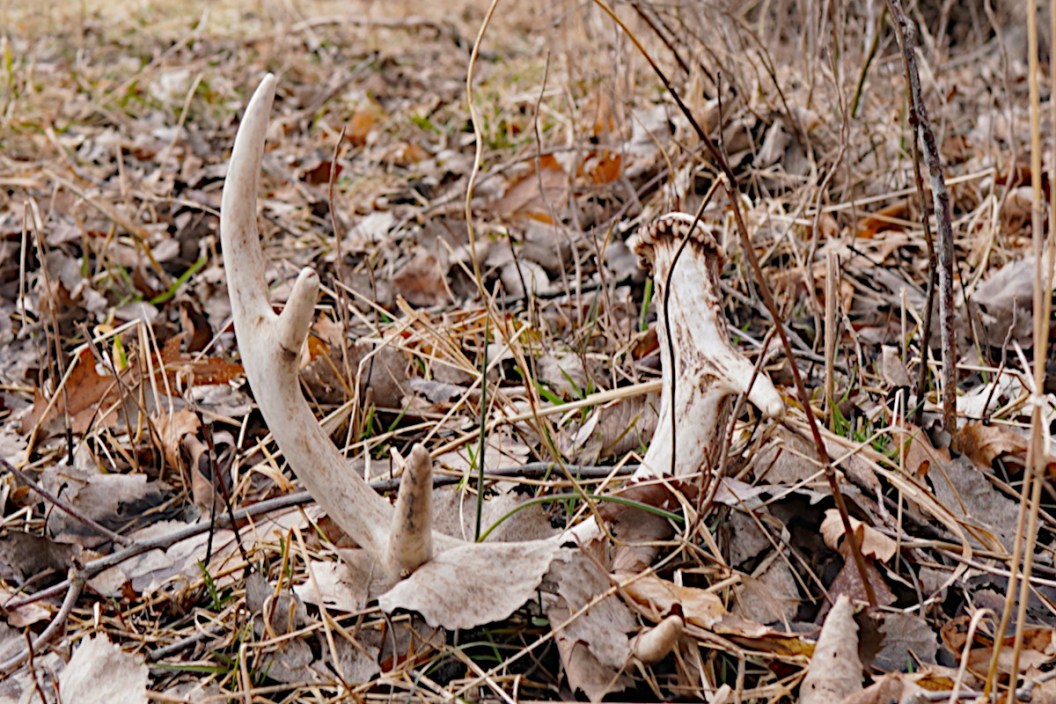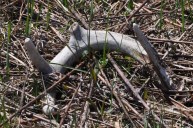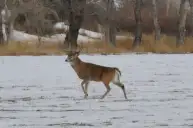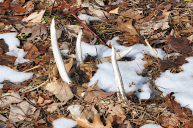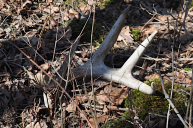Shed hunting Michigan is tough, but it can be done.
As I walked past my treestand over to the puddle of standing water in the forest, I glimpsed what looked like tines poking out of the standing water. As I came closer, it immediately became apparent from the milky white coloration and the layout that I was looking at a brow tine, G2, and G3 just barely breaking the surface. Had the water been any higher, I might have missed seeing the shed antler completely.
After using a stick to pull the small 4-point side out of the water, I stood up, glanced to the side, and immediately felt dumb. The matching side was also laying in the water only about six feet away, and I hadn't spotted it until then.
The tines were sticking barely half an inch above the shallow water's surface. It was my second matched set of the year.
It also just goes to show that looking for deer antlers in Michigan can be much harder than other parts of the country. These antlers easily could have been lost to time. As soon as the rains that accompany this time of year come, the antlers would be submerged completely, and quickly hidden by dead leaf litter in that swampy area.
After more than 25 years of looking for shed antlers in Michigan, I've discovered many of the tips and techniques that are good for other states don't always translate to the Great Lakes State. Fortunately, I learned how to shed hunt this state the hard way. Now you won't have to do the same. This is how I find shed antlers every year in Michigan.
When do bucks shed their antlers in Michigan?
In my experience, most Michigan bucks seem to start shedding their antlers around the second week of February. Many are completely shed out by March. The earliest in the year I've found a shed is mid-January. There are always outliers to these times though. I've gotten trail camera photos of bucks holding their antlers into late April here before. The factors that affect when deer shed their antlers are going to be different for each animal based on the animal's health, testosterone levels, and other factors. Although it does seem like more bucks shed earlier the more severe the winter. As much as I hate long, lingering snows, those kinds of winters always leave me rubbing my palms together in anticipation. Mainly because it seems to concentrate where bucks shed their antlers more than a mild winter, but we'll talk more about that later.
I should also note that you shouldn't believe the myth that all antlers get completely chewed up if you don't hurry. I've found shed antlers in Michigan in July and even September before. I will note that on private lands in Michigan, it helps a lot if you can hold off searching until March. On public lands that isn't always an option because of the competition of course. In my experience, the less pressure on the deer the better, especially if you have exclusive rights to shed hunt a spot.
Think small when searching.
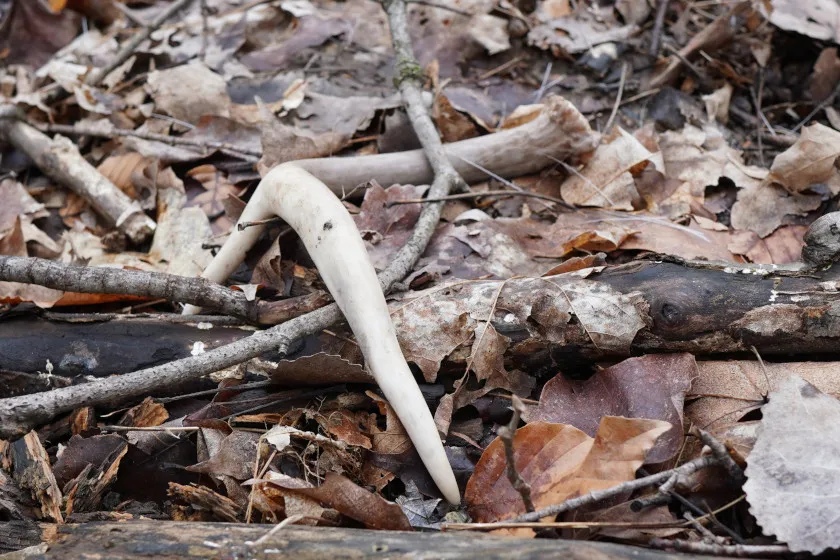
Travis Smola
It's easy to get excited scrolling through Instagram and seeing people piling up the big antlers in Iowa, Illinois, and other states of the Midwest. However, we need to temper expectations in Michigan a little.
Let's be honest; our deer management is not great here. Most whitetail deer do not live to see their second birthday, especially the yearling bucks. You can thank our overly-long deer hunting seasons and bag limits that may be a little too generous. But I digress. The point is, if you go out looking for a sun-bleached 5-point side, odds are you're not going to find it here in Michigan. Unfortunately, I think that's why a lot of Michigan shed hunters get discouraged.
I finally found my first 5-point side this year and it took me nearly 25 years to do that. I've found antlers every year for the last decade, but it took that long to find a 5-point. It's just not easy to find the big ones here.
Speaking of tempering expectations, you also shouldn't expect to find a ton of antlers in Michigan, not without a ton of walking anyway. My record for a year is 11 and I've done that twice. Most years I'm finding around five at the most. They're not easy to find in this state!
Finding sheds in Michigan requires more patience and persistence than it does in other states, and calls for a commitment to looking for smaller antlers. I've found more fork horns than any other type of antler.
There's a lot to explain that we won't get deep into, but it's important to "train your eyes" to look for sheds. And once you do that, you need to commit to only looking for a tiny bit of antler at a time. I'm usually watching for only a few inches of bone. I probably spot more antlers by looking for the curvature of the main beam than anything else.
Unless you're a natural, it takes time to train yourself to do this. For more detail on training and conditioning your eyes, check out this previous piece on the subject. Learn from those tips, and read on for more Michigan-specific pointers.
Where deer shed in Michigan.
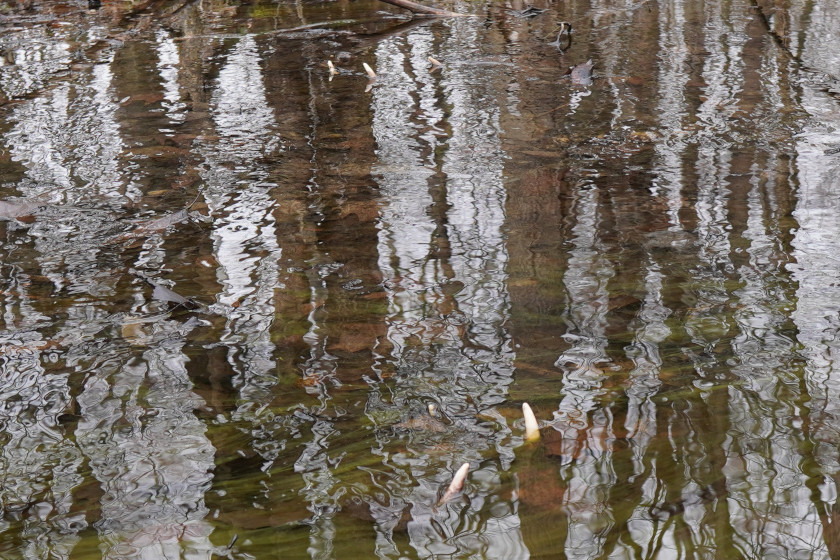
Travis Smola
If I had to estimate, I would guess I've found approximately 70% of my Michigan sheds in feeding areas or tall grass cover over the years, especially after a winter with snow that stays on the ground for weeks at a time. Winters like that help to concentrate the deer in one area and bucks will spend an inordinate amount of time restoring their fat reserves which were exhausted during the rut.
My second favorite spots to look are bedding areas, especially the ones on south-facing slopes. I should note that while I have found antlers while grid-searching bedding areas, they are not usually the areas that pan out best for me. This goes against a lot of the advice you'll read in most shed hunting articles, but I cannot deny my own results favoring feeding and transition tall grass over bedding areas over the years.
Many Michigan hunters, including myself, spent years convinced that all bucks in this state drop their antlers in the thick cover where it's hard to walk ten feet without bending over or brushing through thorns. I can count on one hand the number of sheds I've found in thickets like those. Not only is it hard to search, it's also not usually the place bucks frequent during the winter months. Once the hunting season is over, they know the pressure is off, and they tend to let their guard down a little. They'll start wandering closer to the food and in more open areas when the snows arrive.
Most hunters think because crop fields and food plots are usually more open, they can cover these areas quickly and move on. As a result, they walk right past antlers they should have found had they taken the time to slowly and properly grid-search the area. One of the worst pieces of shed antler hunting advice I ever read about was to use a four-wheeler to cover ground quickly. I did this for years without finding a single shed. I'm convinced now it's because I was going much too fast. I shudder to think of how many antlers I've missed over the years due to improper search techniques.
Another prime area to search is the cover immediately surrounding food sources. Michigan deer are under a ridiculous amount of pressure during deer season. In some areas, the seasons stretch into January, well after the first snow and cold temperatures. At that point in late winter, most bucks are worn down after the rut and they just want to eat. However, they're not stupid about it. They still like to stage up along the edges of these food sources and scope the food plot or field out before they head out.
I've also seen too many shed hunters in Michigan waste time randomly following heavy deer trails through the woods. I usually only start checking the trails closely when I've exhausted the bedding areas, feeding areas, and grassy cover.
Even then, one big thing I've noticed over the years is that the big bucks are rarely using the heaviest of trails. A lot of those tracks are does and fawns. Many bucks, especially the older ones, seem to take lighter trails running parallel to those, especially if there's more cover.
Don't forget about water. Last September I found a small three-pointer ten yards inside the woods off a public Lake Michigan beach in the Upper Peninsula. That find came after I found a 110-inch matched set from a big 7-point while kayaking a river in July. The 4-point side was what caught my eye when I spotted it laying on the bank. The 3-point match was sitting in the river itself right next to it. If there's a pond or river running through the area you shed hunt, you owe it to yourself to check the shores of it closely. Don't forget to look IN the water too. Case in point: my submerged pair mentioned earlier.
Other things to keep in mind.
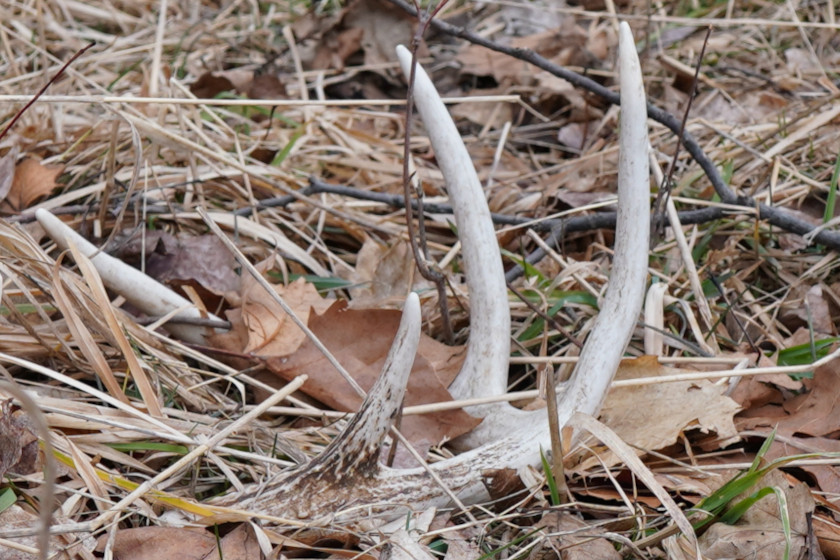
Travis Smola
The biggest thing I've learned about Michigan deer over the years is that they don't behave like the majority of other deer. The animals here receive so much pressure from deer hunters that there is often little rhyme or reason to many of their behaviors. Many articles will tell you not to look for sheds in the same places where you had a sighting during deer season. However, Michigan deer usually don't follow those rules. If an area provides food, water, and cover, many bucks are content to stick to the same area all season. This is especially true of areas that receive little hunting pressure.
Although you should also be aware many Michigan bucks will also sometimes roam a larger-than-normal area than other states. Case in point: I've found sheds from bucks I watched all season before, but I also sometimes find random sheds from deer I later learned were photographed most of year three to five miles away. You're more likely to find those roamers during a mild winter when bucks aren't stressed about finding food. Most hunters associate a buck's wanderlust with seeking out does during the rut, but some will continue wandering well after the rut is over.
The bigger point is that sheds can be found almost everywhere in Michigan. If you've exhausted the obvious spots, it's time to move to the less obvious ones. Think way outside the box. The biggest shed I've ever found was from an urban buck. I found that 65+ inch, four-point side in a tiny patch of woods behind a movie theater. The antler was laying less than thirty yards from a heavily-used bike path and forty yards from a road! Michigan bucks are extremely smart and will seek sanctuary wherever they can find it sometimes. Shed hunters who are successful here year in and year out know how to find these honey holes.
Most of all, I encourage anyone interested in shed hunting to not give up no matter where they're searching. It takes time and patience to find antlers in Michigan. However, if I can pull it off year after year, I'm convinced anyone can at this point. Get out there and burn some boot leather, and you may be surprised at what you find.
For more outdoor content from Travis Smola, be sure to follow him on Twitter and Instagram For original videos, check out his Geocaching and Outdoors with Travis YouTube channels.
READ MORE: 7 SHED HUNTING TIPS FOR THOSE WHO JUST CAN'T SEEM TO FIND THEM
